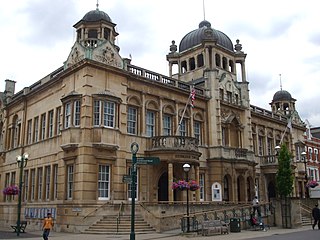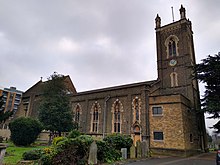
Ilford is a large town in east London, England, 9 miles (14 km) north-east of Charing Cross. Part of the London Borough of Redbridge, Ilford is within the ceremonial county of Greater London. It had a population of 168,168 in 2011, compared to 303,858 for the entire borough.

Chadwell Heath is an area in East London, England. It is split between the London Borough of Barking and Dagenham and the London Borough of Redbridge, around 2 miles (3.2 km) west of Romford and 4 miles (6.4 km) east of Ilford, and 12 miles (19 km) north-east of Charing Cross.

Manaton is a village situated to the southeast of Dartmoor National Park, Devon, England.

Little Ilford is a district of London, England in the London Borough of Newham and the name of a ward in that borough.

Ilford was a civil parish and local government district in south west Essex, England from 1888 to 1965, covering the town Ilford. The district saw a considerable rise in population throughout its life, caused by the expansion of the built-up area of London, and became one of the most populous districts of its type in England. The district now corresponds to the greater part of the London Borough of Redbridge in Greater London.

George Halford Fellowes Prynne (1853–1927) was a Victorian and Edwardian English church architect. Part of the High Church school of Gothic Revival Architecture, Prynne's work can be found across Southern England.

The Parish Church of St Jude-on-the-Hill, is the parish church of Hampstead Garden Suburb in north London. The suburb was founded in 1907 by Henrietta Barnett to be a model community where all classes of people could live together in attractive surroundings and social harmony.

Kea is a civil parish and village in Cornwall, England, United Kingdom. It is a "large straggling parish" in a former mining area south of Truro.

St Peter's Church is a church in Brighton in the English city of Brighton and Hove. It is near the centre of the city, on an island between two major roads, the A23 London Road and A270 Lewes Road. Built from 1824–28 to a design by Sir Charles Barry, it is arguably the finest example of the pre-Victorian Gothic Revival style. It is a Grade II* listed building. It was the parish church of Brighton from 1873 to 2007 and is sometimes unofficially referred to as "Brighton's cathedral".

St Matthew's Church, Westminster, is an Anglican church in Westminster, London. Located in the heart of the capital, close to the Houses of Parliament, Westminster Abbey and Church House, St Matthew's has been closely associated with the recovery of the Catholic heritage of the Church of England from its early days. One of the foremost leaders of that movement, Frank Weston, Bishop of Zanzibar, served at St Matthew's from 1916–1918.

St John the Divine, Kennington, is an Anglican church in London. The parish of Kennington is within the Anglican Diocese of Southwark. The church was designed by the architect George Edmund Street in the Decorated Gothic style, and was built between 1871 and 1874. Today it is a grade I listed building.

St Peter's Church is an Anglican church in the London Borough of Lambeth. It is a Grade II* listed building and occupies a prominent position in Leigham Court Road, Streatham.

The Hospital Chapel of St Mary the Virgin and St Thomas of Canterbury, Ilford, also known as Ilford Hospital Chapel is on Ilford Hill in Ilford. It is an ancient charitable foundation dating from about 1140, and is the oldest building in the London Borough of Redbridge. Since 1954 it has been protected as a Grade II* listed building under UK legislation.

St Peter's Church, Ealing, is an Anglican parish church in Mount Park Road, North Ealing, in the Diocese of London, regarded by Sir John Betjeman a church "of which we can justafiably be proud. Held to be one of the premier architectural works in Ealing, the Grade II* Listed building is noted for its combination of Arts & Crafts and late-Victorian Gothic as well as its west front and great west window. In addition to Sunday and weekday services, the church and adjacent hall serve as a hub for various community activities and events.

Holy Trinity Church, St Austell is a Grade I listed parish church in the Church of England in St Austell, Cornwall.
St Clement's Church, Ilford was a Church of England church on Park Avenue in Ilford in the London Borough of Redbridge. It was built between 1889 and 1896. The land for the building was donated by Mrs Clement Ingleby of Valentines and the building designed by Cutts Brothers. Initially a chapel of ease to St Mary's Church, Ilford, it replaced it as the parish's main church in 1902. Its vicar was appointed by All Souls College, Oxford. It was demolished in 1977.
Edward Revell Eardley-Wilmot was a Church of England clergyman. He served for a time as an army officer, in the Bengal Artillery.

Edward Arthur Fellowes Prynne (1854–1921) was a leading British late Pre-Raphaelite painter of portraits and subject pictures, who in later life became one of the country's best-known creators of decorative art for churches.

St Mary the Virgin Church is a partly medieval Grade II* listed flint church on Church Road in Hayes, Hillingdon. The central portion of the church, the chancel and the nave, was built in the 13th century, the north aisle in the 15th century, and the south aisle in the 16th century, along with the lychgate and the south porch.

St Saviour's Church was a late-Victorian Church of England church in the London Borough of Ealing, designed by the architect George Fellowes Prynne and destroyed during the Second World War.





















